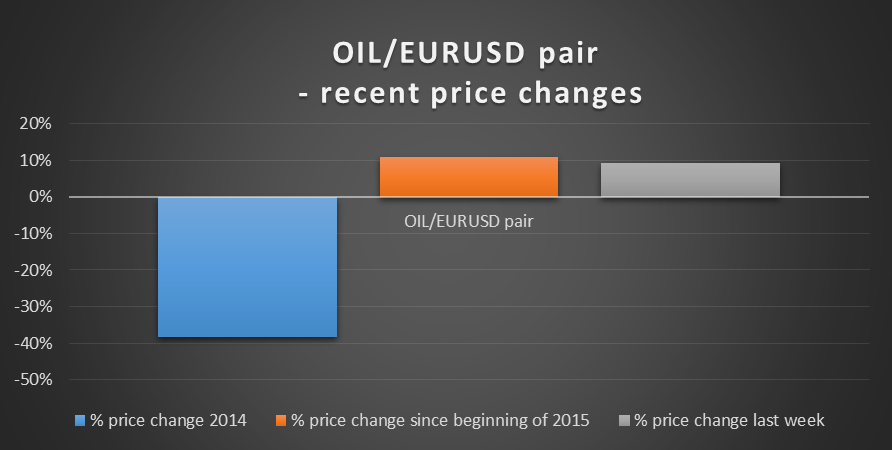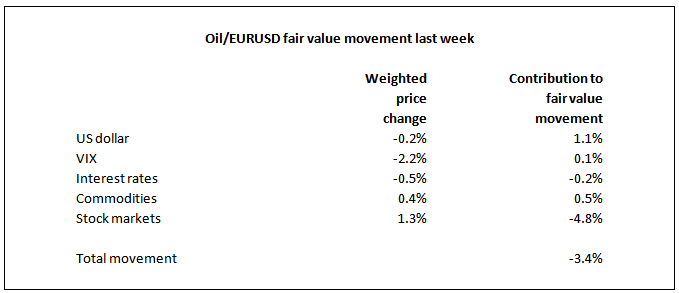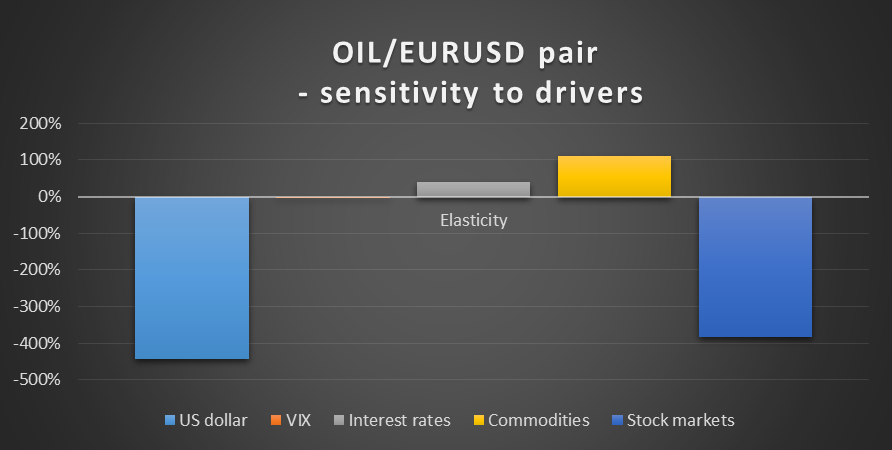The oil price has enjoyed a small resurgence in recent weeks with a lift off its three-year low of $43.39 on 17 March 2015 to $53.57 at the time of writing. EUR/USD has also firmed from its low of 1.0495 on 13 March 2015 to the current 1.0936, but the pair long oil short EUR/USD has appreciated this year. The graph below shows the performance of a pair ratio of 200 bbl of crude (long) to EUR 10,000 of USD (short).

Over the last week, oilrose9.7% whilst EUR/USD firmed 0.4% to give a 9.2% increase in the price of the pair. This was accompanied by a 3.4% decrease in its fair value,driven by the factors analyzed in the table below –

The combination of price increase and fair value decrease would normally be a signal to sell the pair (buy EUR/USD, sell oil). Following this signal over the last 90 days would have provided an annualized gain (on gross – long plus short - exposure) of 35.2% with volatility of 19.7%.
We have also applied this methodology to a number of other pairs of related securities – EUR/USD/gold, natural gas/GBP/USD, DAX/S&P 500, palladium/copper, /ASX200/FTSE and CAC40/Nikkei. The portfolio of all these pairs traded using the disparity between price and fair value change (as above) has returned an annualized 35.4% with volatility of 4.8% over the 90 day backtest period. Hence the methodology supporting our recommendation backtests well over a range of securities.
We find a fair value of the oil/EUR/USD pair below the current price, suggesting that the pair is overvalued. Whilst this appears to confirm the signal analyzed above, trading the pair using an under/over value indicator over the 90 day backtest period showed a negative return, so for oil/EUR/USD do not draw comfort from this indicator.
Relationship to drivers and volatility
The graph below shows the sensitivity of the pair’s fair value to its drivers –

The long oil/short EUR/USD pair is on balance negatively correlated to the US dollar because the oil price is highly negatively correlated to the USD. Our fair value indicators now suggest some short term upside in the US dollar index which would assist the long EUR/USD/short oil pair trade recommended above.
An event potentially driving some movement in USD this week is the FOMC Minutes release on Wednesday. EUR could move on the release of EMU PMI data (Wednesday). This week will be fairly rich in January and February economic data releases for the euro area countries.
The volatility of the pair, at 19.7%, is much closer to that of EUR/USD (13.9%) than oil (54.3%) suggesting that the pair trade is a low volatility way of taking a position on the oil price.
Held in combination with a US equity portfolio, lower volatility and higher return may be achieved. A portfolio of 5% allocated to the pair (traded as recommended in this article) and 95% allocated to the S&P 500 index had a volatility of 12.5% over the last 90 days vs13.4% for 100% in the S&P 500. The annualized returns were 4.0% (5% allocated to pair) vs2.4% (100% S&P 500).
